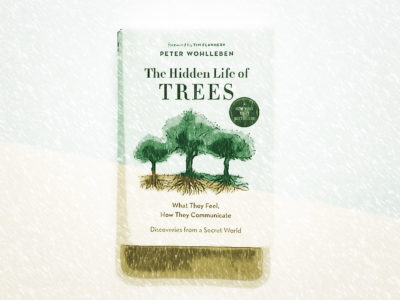Trees and animals? Yes, indeed.
Our understanding of tree behavior is changing, thanks to new forest research and Peter Wohlleben’s book, The Hidden Life of Trees.
He’s a professional forester who manages the trees for the community of Hummel in Germany. Like most forestry students he was taught that trees are just resources to be managed, and their only real value is on the lumber market.
But after years of watching forest visitors marvel over trees of so-called low commercial value, he began to change his views and his management practices.
“Sometimes I suspect we would pay more attention to trees and other vegetation if we could establish beyond a doubt just how similar they are in many ways to animals.”
In his book, he presents a view of trees as living beings carrying on their own lives right beside us, but at a pace so slow it’s hard to notice. (Electrical signals run through a tree at a rate of only one-third of an inch per minute!)
Here are a few of the ways trees are like animals:
Trees Communicate
I shared a video about how trees send messages to each other through their root systems, but they also communicate through the air.
When a tree is being eaten by an animal or an insect, it defends itself by pumping unsavory or toxic chemicals into its leaves. As it does this, it also emits chemicals into the air to alert other parts of its own structure and other nearby trees to prepare for an attack.
In the case of an insect attack, the tree may also send out chemicals that tell the insect’s predators where to find it.
“In the symbiotic community of the forest, not only trees but also shrubs and grasses—and possibly all plant species—exchange information this way.”
Trees Move
In fantasy and fairy tale movies trees uproot themselves and walk around, but in real life they are far less dramatic—they move one generation at a time.
They migrate by way of seed dispersal and each species has its own method and desired speed. Some have seeds that are light and feathery, designed to be carried long distances by the wind. Others have heavy, oily seeds, designed to be transported shorter distances by squirrels and birds.
Whatever the method, trees move year by year and mile by mile, or quarter mile in the case of the beech, towards the most favorable conditions.
In the absence of human interference, overgrazing by herbivores, or inconveniently located mountain ranges, entire forests migrate across continents as the climate shifts.
Trees Share
Trees of the same species growing in the same location connect to each other through their roots. This lets them share food, water, and messages with each other.
In undisturbed beech forests, research has shown that trees grow as a community. Trees that are stronger than the rest or have better access sunlight and water, will moderate their performance. They will send their own resources to weaker and less favorably placed trees, so the entire forest grows at a similar pace.
In some cases, they will also do this with other species
“Their well-being depends on their community, and when the supposedly feeble trees disappear, the others lose as well. When that happens, the forest is no longer a single closed unit. Hot sun and swirling winds can now penetrate to the forest floor and disrupt the moist, cool climate.”
The author also discusses how trees breathe, hibernate, and clean their surroundings. He even mentions the controversial possibility that they have brains in their roots.
Next time you’re in the woods, keep in mind that those trees have a lot going on.
*All quotes from The Hidden Life of Trees by Peter Wohlleben

 Irises
Irises